International Affairs
 |
 |
 |
 |
 |
 |
 |
Urban Guerilla Warfare in Ecuador
the enemy happens to be: to his home,
to his centers of entertainment: a total war."
Che Guevara
These words of the bloodthirsty leader of the Cuban Communist Revolution are very timely today. They can well explain the riots that have taken place in Ecuador and Chile, shaking the stability of these countries in October and November 2019.
Ecuador is in a difficult economic situation. The previous Marxist government of Rafael Correa left the country in poverty and, worse, it compromised Ecuador’s future by taking loans at usurious rates from China.
So, the present day government led by Lenin Moreno went to the IMF and got a loan to pay back the debts. In turn, the IMF demanded austerity conditions, that is, the elimination of subsidies and the reduction of State bureaucracy. The agreement was sealed. After the first IMF disbursement, the government announced it would eliminate the fuel subsidy, which translated into an increase in gasoline prices. That was the trigger the Revolution was waiting for.
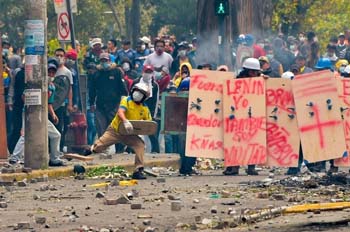
Stones-throwers shoot & run back to the area protected by shields of the same size: an urban guerilla strategy
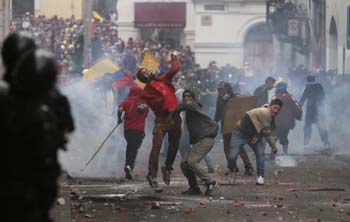
However, after the government suspended the classes in the colleges and made an agreement with the transport union leaders, the riot should have stopped. It did not. So, the real agents of the insurgency appeared. They revealed themselves to be trained anarchic and destructive agitators who had no interest in a better future for Ecuador. A number of videos show them in action, looting private stores, vandalizing cars and destroying whatever they found, especially poorly guarded public buildings (here).
Supported by statistical data, the Minister of Defense General Oswaldo Jarrín appeared before the Parliamentary Commission investigating this national situation. He affirmed that the police and army were not duly prepared to simultaneously face a transportation strike and this indigenous insurgency. To cope with this insurgency, the army had to restructure, to improvise. So, with an unprepared security system, the country suddenly found itself on the brink of war.
It was a scenario of well-planned urban guerilla warfare. It did not take long to realize that the supposed spontaneous “strikers” were following strategies designed for urban street conflicts. They had all the necessary hand-made weaponsto face the police and a supply of manufactured shields to protect themselves.
Their street demonstrations were all meticulously planned and many of the participants were well trained, with the first rows carrying shields, followed by protesters with improvised bazookas and homemade rocket launchers. After them were others throwing Molotov cocktails with a fuel that was later found to include chemicals that would adhere to the clothing or skin of the victims. Behind them it was possible to identify a center command directing the action and agents delivering the orders.
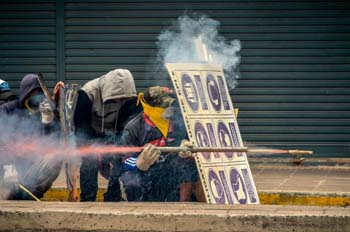
Small rockets launched from iron pipes reveal a well-planned strategy
I believe the courage and patriotism that both our military and police personnel displayed in dispelling this violence should be praised. Without lethal weapons and with almost no deterrent arms, they placed their lives at risk to face this horde of trained rioters, It should be noted that the previous Correa government had undermined and weakened these two institutions as much as possible, while promoting and developing the "Defense Committees of the Revolution," which followed the model of the Venezuelan paramilitary guerilla groups.
The fact that the police were not properly armed explains why the rioters were able to kidnap – which they termed "to peacefully retain" – police and military officers as well as journalists. We have seen in videos the shameless boldness of those so-called indigenous rioters threatening, mistreating and humiliating the police officers, especially the female officers.
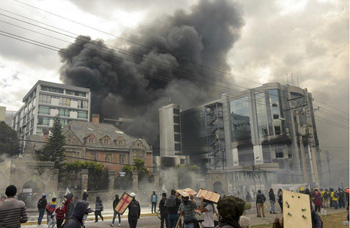
Smoke of the burned archives & furniture of the Controller State Building, at right
Well, during the October riots, that building was taking over by the “indigenous” mobs, and the fifth floor – which housed the Correa files – was targeted. Everything in those rooms – including the archives with those files – were thrown out the windows and burned.
What is the link between a fuel price hike and a mob of criminals that destroys and burns the archives and furniture of a public building?
Psychological effect on public opinion
This episode of urban guerilla deeply harmed the mental and psychological equilibrium of our Ecuadorian people.
Our society and its assets, including national treasures, were violently attacked, looted and vandalized, many of these buildings and goods were destroyed and burned to ashes. The newspaper El Universo reported that initial calculations point to $ 2.3 billion of damage.
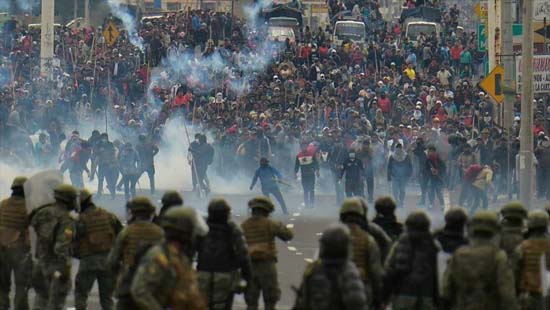
Under-armed police & military bravely face the mobs
Psychologically speaking, the urban guerillas and the inefficiency of the police and military forces to contain the mob violence created an ambience of insecurity, fear and even panic in a defenseless population.
Politically speaking, the Moreno government backed down and made all possible concessions to the “indigenous” protesters. It called off the price hike on fuel and offered representatives of the “indigenous” a seat at the table, giving them a say in future government decisions.
Support of the Church
To all of the above, I must add that five universities provided protection and logistical support to the protesters. The two that stand out are the Salesian Polytechnic University and the Jesuit Pontifical Catholic University of Ecuador. They were fully backed by the Archbishop of Quito Alfredo Espinoza and the Ecuadorian Bishops Conference, but this is a subject that I will address later.
The smoke from the riots and the smell of tear gas in Quito had not completely dissipated when, just as suddenly and apparently spontaneously, more revolutionary urban guerilla riots emerged in Chile, the country with the highest standard of living in Latin America, so far. I hope to address this topic in another article soon.
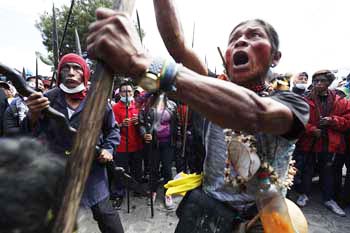
Indians from the Ecuadorian Amazon joined the protests.
Were they concerned about fuel prices or shipped in for the guerilla?

Posted November 22, 2019
______________________
______________________
 Volume I |
 Volume II |
 Volume III |
 Volume IV |
 Volume V |
 Volume VI |
 Volume VII |
 Volume VIII |
 Volume IX |
 Volume X |
 Volume XI |
 Special Edition |


